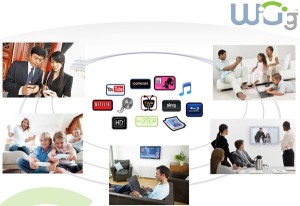The WiGig high-speed wireless standard will power a new wireless version of USB through a deal between the Wi-Fi Alliance and the USB Implementers Forum. 
The Wi-Fi Alliance has transferred a specification for the WiGig high-frequency technology to the USB-IF as part of a broader effort to work with third parties to make WiGig useful.
WiGig can achieve several times the speed of Wi-Fi by using unlicensed 60GHz frequencies within a short range, typically within one room. The new Wireless USB specification will use existing USB 2.0 and 3.0 drivers and APIs, which should make it easy to add to new devices. It could be used for any type of data transfer typically associated with USB, such as backing up content or linking peripherals to a PC.
The move, to be announced Monday at the Intel Developer Forum (IDF), is part of a new approach that the Wi-Fi group is taking with WiGig, according to Kelly Davis-Felner, Wi-Fi Alliance marketing and program management director. The WiGig Alliance became part of the Wi-Fi Alliance late last year.
The new wireless form of USB, called Media Agnostic USB, will be able to use any kind of wireless system, according to the USB-IF. It is being defined for multiple media, including WiGig, Wi-Fi and WiMedia UWB (ultrawideband). A work group within the USB-IF is developing the MA USB 1.0 specification.
In a first for the owner of one of the best-known tech brand names, the Wi-Fi Alliance will use the WiGig brand by itself when it starts certifying devices for that technology, giving them a WiGig Certified logo. The first official WiGig seals of approval are expected to go out next year. Up until now, all of the group’s certifications have fit under Wi-Fi itself.
The Alliance will also partner with other industry bodies for certification of WiGig-equipped products designed for specific uses of the technology, Davis-Felner said. While the Wi-Fi Alliance will certify a product’s WiGig interoperability, the partner groups will work on the higher-level features implemented on top of WiGig, she said.
The first two such partnerships are the arrangement for USB and a liaison agreement with the Video Electronics Standards Association (VESA). The VESA deal will facilitate the certification of products that use the WiGig Display Extension Specification for streaming video from PCs and handheld devices to TVs and monitors, the Wi-Fi Alliance said.
WiGig is intended to carry video, audio and data at high speeds over unlicensed frequencies in the 60GHz range, far above the bands used by Wi-Fi. WiGig is faster than Wi-Fi, up to 7Gbps (bits per second), but works over shorter distances. It emerged as a proposed specification in 2009 with the backing of major vendors including Microsoft, Intel and Samsung.
Supporters formed the WiGig Alliance, which last year merged with the Wi-Fi Alliance. But the WiGig name is so well-known that the more established industry group decided to stick with the original name.
“It was starting to get a fair amount of industry traction,” Davis-Felner said.
The USB-IF has been certifying Wireless USB devices with UWB for several years, with “some moderate adoption,” according to Jeff Ravencraft, USB-IF’s president and chief operating officer. UWB, which uses a wide range of different frequencies, fizzled in the market after it failed to deliver promised performance, according to Farpoint Research analyst Craig Mathias.
While the Alliance certifies a number of Wi-Fi technologies with different purposes, such as Wi-Fi Direct, most of the products it approves are designed to participate in wireless LANs around a building or an outdoor area.
Many WiGig products will also have Wi-Fi, along with mechanisms for smooth handovers between the two technologies, according to the Alliance. But not all WiGig products will use both, the group said.
As a well-established and successful certification body, the Wi-Fi Alliance realized it might be able to take on that task for other technologies, Davis-Felner said. “It was … a significant decision to realize that the scope of our organization had extended past what most people in the world think of Wi-Fi,” she said.
“People don’t want to go to a different trade association for every technology that’s going to be in a product,” Davis-Felner said. “The more we can be a one-stop shop for the industry, the better off everybody is.”
Still, the group is staying fairly close to its home territory: The most likely candidates for expansion would be ones that use unlicensed wireless spectrum and don’t already have an established trade association, she said.
Also at IDF, 60GHz chip maker Wilocity and display connectivity vendor DisplayLink will demonstrate sending high-resolution 4K video from a laptop to a monitor via WiGig, using a WiGig docking station.





